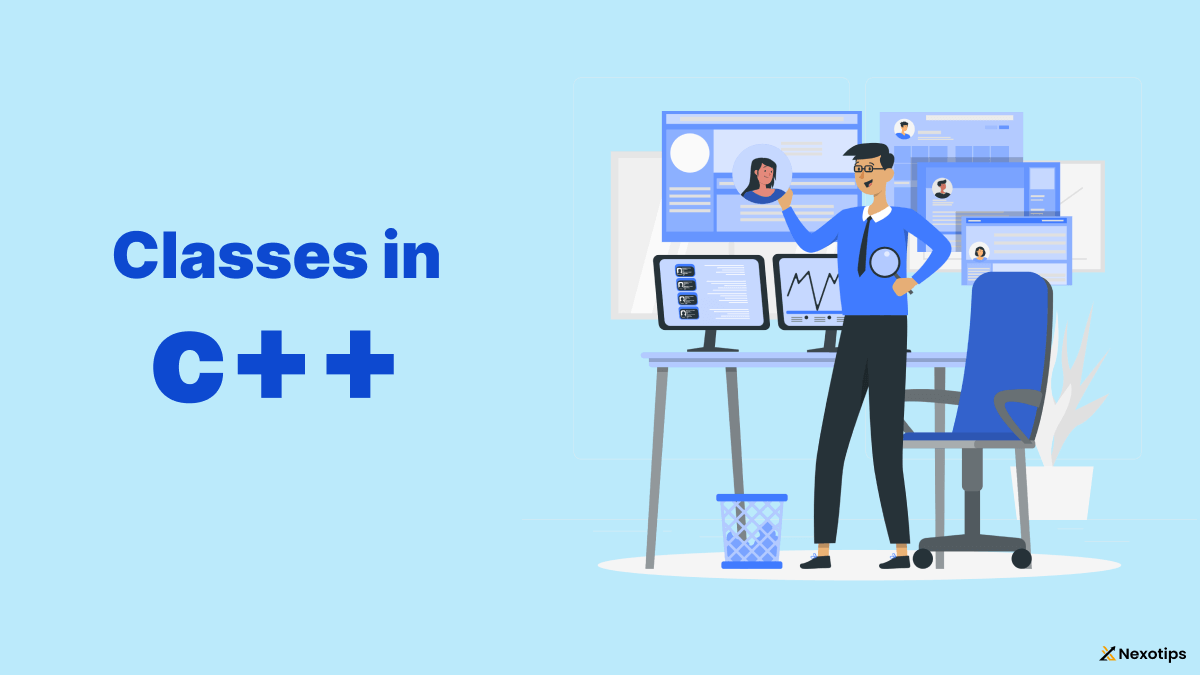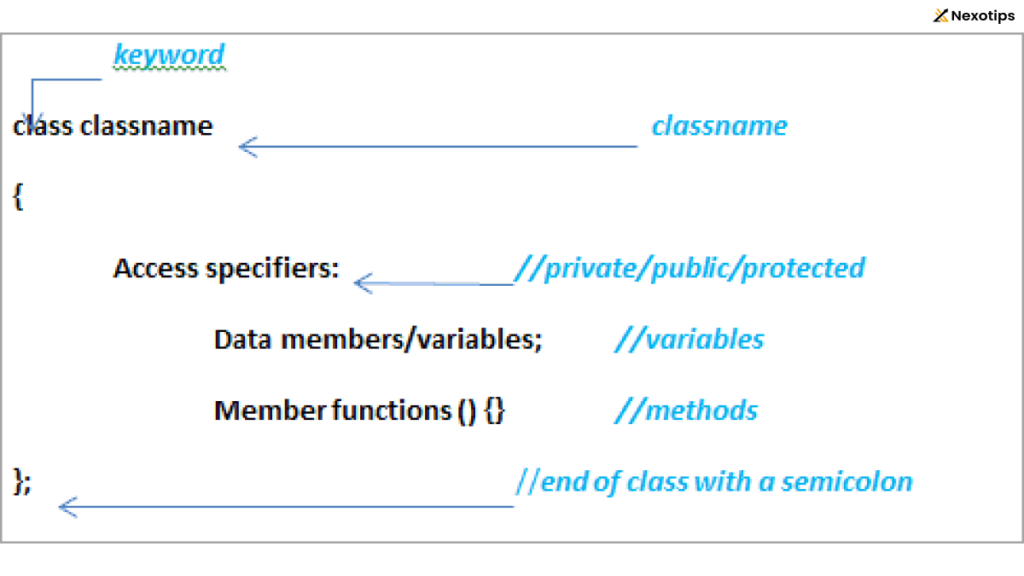
Best way to learn C++ Classes for 2024 : Concepts, Implementation, and Best Practices
Table of Contents
Best way to learn C++ Classes, One of the core features that make C++ a robust and versatile language is its support for Object-Oriented Programming (OOP). At the heart of OOP in Best way to learn C++ Classes is the concept of classes. This blog will take an in-depth look at Best way to learn C++ Classes, their importance, implementation, and best practices for using them.
Best way to learn C++ Classes
In Best way to learn C++ Classes, a class is a blueprint for creating objects.It contains information for the object and functions to operate on that information. This concept is central to Best way to learn C++ Classes, allowing developers to model real-world entities and manage code complexity by bundling data and behavior.
Best way to learn C++ Classes Key Concepts:
- Object: An instance of a class.
- Class: Defines a type including its interface and implementation.
- Data Members: Variables that hold the data of the object.
- Member Functions: Functions that operate on the data members of the class.
Best way to learn C++ Classes not only help in structuring complex programs but also provide mechanisms for code reuse, inheritance, and polymorphism, making In Best way to learn C++ Classes and it’s a powerful tool for software development.
2. Basic Structure of a C++ Class
A basic C++ class consists of the following parts:
- Class name
- Data members
- Member functions
- Access specifiers
Example:
class Rectangle {
private:
double length;
double width;
public:
// Constructor
Rectangle(double l, double w) {
length = l;
width = w;
}
// Member function to calculate area
double area() {
return length * width;
}
};
In this example, Rectangle is a class with two private data members (length and width) and a public member function (area()) that calculates the area of the rectangle.
3. Constructors and Destructors
Constructors and destructors are unique member functions utilized for setting up and tearing down objects.
Constructors:
- The class and its constructor share the same name.
- It initializes the object’s data members.
- It can be overloaded.
Destructors:
- The destructor shares the name of the class, but with a tilde (~) before it.
- It is called when an object is destroyed.
- It cannot be overloaded.
Example:
class Circle {
private:
double radius;
public:
// Default constructor
Circle() {
radius = 1.0;
}
// Parameterized constructor
Circle(double r) {
radius = r;
}
// Destructor
~Circle() {
// Cleanup code if needed
}
// Member function to calculate area
double area() {
return 3.14159 * radius * radius;
}
};
4. Member Functions and Data Members
Data Members:
Data members store the state of an object. They can be of any data type, including primitive types, pointers, and other classes.
Member Functions:
Member functions define the behavior of an object. Best way to learn C++ Classes definitions can be contain definitions of the variables either inside or outside the class itself.
Example:
class BankAccount {
private:
double balance;
public:
// Constructor
BankAccount(double initialBalance) {
balance = initialBalance;
}
// Function to deposit money
void deposit(double amount) {
balance += amount;
}
// Function to withdraw money
void withdraw(double amount) {
if (amount <= balance) {
balance -= amount;
} else {
std::cout << "Insufficient funds!" << std::endl;
}
}
// Function to check balance
double getBalance() {
return balance;
}
};
5. Access Specifiers: Public, Private, and Protected
Access specifiers control the access level of the class members. There are three types of the access specifiers in C++:
- Public: Members declared public can be accessed from outside the class.
- Private: Members declared private can only be accessed from within the class.
- Protected: Members declared protected can be accessed from within the class and by derived classes.
Example:
class Person {
private:
std::string name;
int age;
protected:
std::string address;
public:
Person(std::string n, int a) : name(n), age(a) {}
void display() {
std::cout << "Name: " << name << ", Age: " << age << std::endl;
}
};
In this example, name and age are private, meaning they cannot be accessed directly from outside the class. The address is protected, and the display function is public.
6. Inheritance and Polymorphism
Inheritance:
Inheritance allows a class to inherit properties and behavior from another class. The base class is the class being inherited from, while the derived class is the class that inherits.
Example:
class Animal {
public:
void eat() {
std::cout << "This animal is eating." << std::endl;
}
};
class Dog : public Animal {
public:
void bark() {
std::cout << "The dog is barking." << std::endl;
}
};
In this example, Dog inherits from Animal, meaning Dog can use the eat function from Animal.
Polymorphism:
Polymorphism allows functions to be used interchangeably with objects of the different types. It can be achieved through function overloading, operator overloading, and inheritance.
Example:
class Shape {
public:
virtual void draw() {
std::cout << "Drawing a shape." << std::endl;
}
};
class Circle : public Shape {
public:
void draw() override {
std::cout << "Drawing a circle." << std::endl;
}
};
class Square : public Shape {
public:
void draw() override {
std::cout << "Drawing a square." << std::endl;
}
};
void drawShape(Shape &s) {
s.draw();
}
In this example, drawShape can accept any object of a class derived from Shape, and the appropriate draw function will be called at runtime.

7. Encapsulation and Data Hiding
Encapsulation is the process of bundling data and methods that operate on that data within a single unit or class. It restricts direct access to some of the object’s components, which is a means of the preventing accidental interference and misuse of the methods and data.
Example:
class EncapsulatedData {
private:
int hiddenData;
public:
void setHiddenData(int data) {
hiddenData = data;
}
int getHiddenData() {
return hiddenData;
}
};
In this example, hiddenData is private and can only be accessed through the public methods setHiddenData and getHiddenData.
8. Friend Functions and Friend Classes
A friend function or class can access the private and protected members of another class.
Friend Function Example:
class Box {
private:
double width;
public:
friend void printWidth(Box b);
void setWidth(double w) {
width = w;
}
};
void printWidth(Box b) {
std::cout << "Width of box: " << b.width << std::endl;
}
Friend Class Example:
class Base {
private:
int value;
public:
Base() : value(0) {}
friend class FriendClass;
};
class FriendClass {
public:
void setValue(Base &b, int v) {
b.value = v;
}
int getValue(Base &b) {
return b.value;
}
};
9. Operator Overloading
Operator overloading allows C++ operators to be redefined and used in user-defined classes. It provides a way to implement operations involving user-defined types.
Example:
class Complex {
private:
double real;
double imag;
public:
Complex() : real(0), imag(0) {}
Complex(double r, double i) : real(r), imag(i) {}
Complex operator + (const Complex &c) {
return Complex(real + c.real, imag + c.imag);
}
void display() {
std::cout << real << " + " << imag << "i" << std::endl;
}
};
int main() {
Complex c1(3.0, 4.0);
Complex c2(1.0, 2.0);
Complex c3 = c1 + c2;
c3.display();
return 0;
}
In this example, the + operator is overloaded to add two Complex objects.
10. Templates and Generic Programming with Classes
Templates in Best way to learn C++ Classes allow functions and classes to operate with generic types. This allows a function or class to work on different data types without being rewritten for each one.
Example:
template <typename T>
class Calculator {
public:
T add(T a, T b) {
return a + b;
}
T subtract(T a, T b) {
return a - b;
}
};
int main() {
Calculator<int> intCalc;
Calculator<double> doubleCalc;
std::cout << "Int add: " << intCalc.add(1, 2) << std::endl;
std::cout << "Double add: " << doubleCalc.add(1.1, 2.2) << std::endl;
return 0;
}
In this example, the Calculator class can operate on both int and double types.
11. Real-World Examples and Use Cases
Example 1: Banking System
A class can be used to represent a bank account in a banking system.
class BankAccount {
private:
std::string accountNumber;
double balance;
public:
BankAccount(std::string accNum, double initialBalance) {
accountNumber = accNum;
balance = initialBalance;
}
void deposit(double amount) {
balance += amount;
}
void withdraw(double amount) {
if (amount <= balance) {
balance -= amount;
} else {
std::cout << "Insufficient funds!" << std::endl;
}
}
double getBalance() {
return balance;
}
};
Example 2: Library Management System
A class can represent a book in a library management system.
class Book {
private:
std::string title;
std::string author;
std::string isbn;
public:
Book(std::string t, std::string a, std::string i) : title(t), author(a), isbn(i) {}
void displayDetails() {
std::cout << "Title: " << title << ", Author: " << author << ", ISBN: " << isbn << std::endl;
}
};
Example 3: Employee Management System
A class can represent an employee in an employee management system.
class Employee {
private:
std::string name;
int id;
double salary;
public:
Employee(std::string n, int i, double s) : name(n), id(i), salary(s) {}
void displayDetails() {
std::cout << "Name: " << name << ", ID: " << id << ", Salary: $" << salary << std::endl;
}
};
12. Best Practices for Using Classes in C++
- Encapsulation: Always use encapsulation to protect the data members of a class. This ensures data integrity and hides the implementation details from the user.
- Single Responsibility Principle :According to the Single Responsibility Principle, every class should have a single responsibility or purpose. This makes the class easier to understand, maintain, and reuse.
- Use Initialization Lists: When defining constructors, prefer initialization lists over assignment inside the constructor body for the better performance.
- Avoid Public Data Members: Avoid making data members public. Use getter and setter functions to provide controlled access.
- Use Const Correctness: Use the
constkeyword to indicate that a function does not modify the object’s state. This provides better code readability and safety. - Prefer Composition Over Inheritance: Use composition to build complex classes by combining simpler ones.Inheritance is appropriate when a distinct “is-a” connection exists.
- Follow RAII: Resource Acquisition Is Initialization (RAII) ensures that resources are properly released when an object goes out of the scope.
- Proper Destructor Implementation: Always implement a destructor if your class manages resources like dynamic memory, file handles, etc., to ensure proper cleanup.
- Use Smart Pointers: Use smart pointers like
std::unique_ptrandstd::shared_ptrto manage dynamic memory and avoid memory leaks. - Document Your Code: Use comments and documentation to explain the purpose of Best way to learn C++ Classes and their members.
13. Conclusion
Best way to learn C++ Classes are essential for the effective object-oriented programming. They allow developers to create modular, reusable, and maintainable code by encapsulating data and behavior. Understanding and implementing classes correctly is crucial for building robust Best way to learn C++ Classes applications. By following best practices, developers can harness the full potential of the Best way to learn C++ Classes and create efficient, high-quality software.
As you continue to explore Best way to learn C++ Classes and object-oriented programming, remember that the concepts of the Best way to learn C++ Classes, encapsulation, inheritance, and polymorphism are powerful tools in your programming arsenal. Whether you’re developing small applications or large-scale systems, mastering these concepts will greatly enhance your ability to write clean, efficient, and scalable code.
Nexotips : Trust us for all your web development needs.
The technology sector is filled with companies that have achieved notable progress in different areas, such as web development and C++ development. This article will focus on some of the leading players in these sectors, highlighting their accomplishments and offering contact details for potential clients by nexotips infotech.
Read More : Elevate Your Programming With C++ Scope : A Deep Dive For 2024
